| Listing 1 - 10 of 31 | << page >> |
Sort by
|

ISBN: 1281137766 9786611137762 0387259198 038725918X 1441938516 Year: 2006 Publisher: Boston, MA : Springer Science+Business Media, Inc.,
Abstract | Keywords | Export | Availability | Bookmark
 Loading...
Loading...Choose an application
- Reference Manager
- EndNote
- RefWorks (Direct export to RefWorks)
Protein Misfolding, Aggregation, and Conformational Disease, is the first book to discuss significant achievements in protein structure-function relationships in the areas of biochemistry, molecular biology and molecular medicine. This volume summarizes recent achievements in the understanding of the relationships between protein misfolding, aggregation and development of protein deposition disorders. Research indicates that various human disorders, including most neurodegenerative diseases, systemic amyloidoses and many others, arise from the misfolding and aggregation of an underlying protein. Protein Misfolding, Aggregation and Conformational Diseases is an ideal book for biochemists, protein scientists, immunologists, pharmaceutical scientists, and molecular and cellular biologists.
Protein folding. --- Proteins --- Conformation. --- Protein conformation --- Folding of proteins --- Folding --- Conformation --- Life sciences. --- Immunology. --- Cytology. --- Life Sciences, general. --- Cell Biology. --- Cell biology --- Cellular biology --- Biology --- Cells --- Cytologists --- Immunobiology --- Life sciences --- Serology --- Biosciences --- Sciences, Life --- Science --- Cell biology.
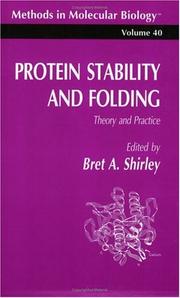
ISBN: 0896033015 9786610836499 1280836490 1592595278 Year: 1995 Publisher: Totowa, NJ : Humana Press : Imprint: Humana,
Abstract | Keywords | Export | Availability | Bookmark
 Loading...
Loading...Choose an application
- Reference Manager
- EndNote
- RefWorks (Direct export to RefWorks)
The intent of this work is to bring together in a single volume the techniques that are most widely used in the study of protein stability and protein folding. Over the last decade our understanding of how p- teins fold and what makes the folded conformation stable has advanced rapidly. The development of recombinant DNA techniques has made possible the production of large quantities of virtually any protein, as well as the production of proteins with altered amino acid sequence. Improvements in instrumentation, and the development and refinement of new techniques for studying these recombinant proteins, has been central to the progress made in this field. To give the reader adequate background information about the s- ject, the first two chapters of this book review two different, yet related, aspects of protein stability. The first chapter presents a review of our current understanding of the forces involved in determining the conf- mational stability of proteins as well as their three-dimensional folds. The second chapter deals with the chemical stability of proteins and the pathways by which their covalent structure can degrade. The remainder of the book is devoted to techniques used in the study of these two major areas of protein stability, as well as several areas of active research. Although some techniques, such as X-ray crystallography and mass spectroscopy, are used in the study of protein stability, they are beyond the scope of this book and will not be covered extensively.
Protein folding --- Proteins --- -Folding of proteins --- Proteids --- Biomolecules --- Polypeptides --- Proteomics --- Conformation --- Folding --- Protein folding. --- Conformation. --- Protein conformation --- Folding of proteins --- Biochemistry. --- Biochemistry, general. --- Biological chemistry --- Chemical composition of organisms --- Organisms --- Physiological chemistry --- Biology --- Chemistry --- Medical sciences --- Composition --- PROTEINS --- PROTEIN FOLDING --- CONFORMATION --- PROPERTIES
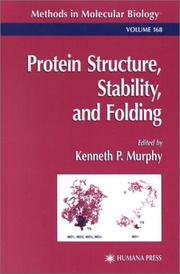
ISBN: 0896036820 0585402248 128082154X 9786610821549 1592591930 9780896036826 1617371327 Year: 2001 Publisher: Totowa, NJ : Humana Press : Imprint: Humana,
Abstract | Keywords | Export | Availability | Bookmark
 Loading...
Loading...Choose an application
- Reference Manager
- EndNote
- RefWorks (Direct export to RefWorks)
With the huge increase in available data on the DNA sequences of proteins, there is a growing need to understand and characterize how proteins fold into their biologically active native states and the basis for the stability of these states. In Protein Structure, Stability, and Folding, Kenneth P. Murphy and a panel of internationally recognized investigators describe some of the newest experimental and theoretical methods for investigating these critical events and processes. Among the techniques discussed are the many methods for calculating aspects of protein stability and dynamics from knowledge of the structure, for calculating conformational entropy, and for performing molecular dynamics simulations of protein unfolding. New experimental approaches presented include the use of co-solvents, novel applications of hydrogen exchange techniques, temperature-jump methods for looking at folding events, and new strategies for mutagenesis experiments. Unique in its powerful combination of theory and practice, Protein Structure, Stability, and Folding offers protein and biophysical chemists the means to gain a more comprehensive understanding of this complex area by detailing many of the major innovative techniques in use today.
Protein folding. --- Proteins --- Conformation. --- Protein conformation --- Folding of proteins --- Folding --- Conformation --- Biochemistry. --- Biochemistry, general. --- Biological chemistry --- Chemical composition of organisms --- Organisms --- Physiological chemistry --- Biology --- Chemistry --- Medical sciences --- Composition --- Protein folding --- Protein Conformation --- Protein Folding --- Structure-Activity Relationship --- 577.122 --- Protein Folding, Globular --- Folding, Globular Protein --- Folding, Protein --- Foldings, Globular Protein --- Foldings, Protein --- Globular Protein Folding --- Globular Protein Foldings --- Protein Foldings --- Protein Foldings, Globular --- Proteostasis --- Protein Multimerization --- Intrinsically Disordered Proteins --- Conformation, Protein --- Conformations, Protein --- Protein Conformations --- 577.122 Protein metabolism --- Protein metabolism --- Relationship, Structure-Activity --- Relationships, Structure-Activity --- Structure Activity Relationship --- Structure-Activity Relationships --- chemistry --- PROTEINS --- PROTEIN FOLDING --- CONFORMATION
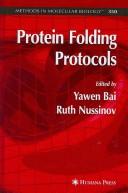
ISBN: 1588296229 1597451894 1280832584 9786610832583 9781588296221 Year: 2006 Publisher: Totowa, NJ : Humana Press : Imprint: Humana,
Abstract | Keywords | Export | Availability | Bookmark
 Loading...
Loading...Choose an application
- Reference Manager
- EndNote
- RefWorks (Direct export to RefWorks)
Protein Folding Protocols presents protocols for studying and characterizing protein folding from the unfolded to the folded state. Covering experiment and theory, bioinformatics approaches, and state-of-the-art simulation protocols for better sampling of the conformational space, this volume describes a broad range of techniques to study, predict, and analyze the protein folding process. Protein Folding Protocols also provides sample approaches toward the prediction of protein structure starting from the amino acid sequence, in the absence of overall homologous sequences. These approaches have tremendous implications, ranging from drug design, functional assignment, comprehension of the nature of regulation, understanding molecular machines, viral entry into cells, and putting together cellular pathways and their dynamics.
Protein folding. --- Proteins --- Conformation. --- Analysis. --- Protein conformation --- Folding of proteins --- Folding --- Proteins -- Analysis. --- Protein folding --- Biophysical Processes --- Biophysical Phenomena --- Conformation --- Cytology. --- Cell Biology. --- Cell biology --- Cellular biology --- Biology --- Cells --- Cytologists --- Protein Folding --- Protein Conformation --- 577.122 --- 577.122 Protein metabolism --- Protein metabolism --- Conformation, Protein --- Conformations, Protein --- Protein Conformations --- Protein Folding, Globular --- Folding, Globular Protein --- Folding, Protein --- Foldings, Globular Protein --- Foldings, Protein --- Globular Protein Folding --- Globular Protein Foldings --- Protein Foldings --- Protein Foldings, Globular --- Proteostasis --- Protein Multimerization --- Intrinsically Disordered Proteins --- Analysis --- analysis --- PROTEINS --- PROTEIN FOLDING --- ANALYSIS --- CONFORMATION
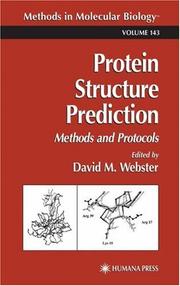
ISBN: 0896036375 9786610842476 1280842474 1592593682 9780896036376 Year: 2000 Publisher: Totowa, NJ : Humana Press : Imprint: Humana,
Abstract | Keywords | Export | Availability | Bookmark
 Loading...
Loading...Choose an application
- Reference Manager
- EndNote
- RefWorks (Direct export to RefWorks)
The deeper understanding of protein structure now emerging from cutting-edge research is not only illuminating evolutionary and biochemical mechanisms, but also promises enormous ramifications for molecular medicine, as well as for biotechnology, biophysics, biology, genetics, and other molecular sciences. In Protein Structure Prediction: Methods and Protocols, world-class investigators detail their most successful methods-and the theory behind them-for delineating the shape, form, and function of proteins. The protocols range from basic to advanced and include sequence alignment, the prediction of transmembrane protein structure, and the development of suitable folding potentials. There are also techniques for receptor site prediction, the identification of motifs and domains, the comparative modeling of proteins, the docking of peptides and ligands, and ab initio approaches to protein loop and side-chain prediction. To ensure robust and successful experimental results, each protocol contains step-by-step instructions, as well as tips on pitfalls to avoid and how procedures may be optimized for different systems. Comprehensive, accessible, and highly practical, Protein Structure Prediction: Methods and Protocols offers protein researchers, structural biologists, and other investigators a critical synthesis of the latest research results, as well as the vital guidance needed to understand the structure and interaction of proteins and peptides.
Amino acid sequence. --- Models, Molecular. --- Probability. --- Protein Conformation. --- Proteins --- Structure --- Mathematical models. --- Amino acid sequence analysis --- Analysis, Amino acid sequence --- Peptide sequence --- Peptide sequencing --- Protein sequence --- Protein sequencing --- Sequence, Amino acid --- Amino acids --- Sequence alignment (Bioinformatics) --- Proteids --- Biomolecules --- Polypeptides --- Proteomics --- Analysis --- Biochemistry. --- Biochemistry, general. --- Biological chemistry --- Chemical composition of organisms --- Organisms --- Physiological chemistry --- Biology --- Chemistry --- Medical sciences --- Composition --- Amino acid sequence --- Protein Conformation --- Models, Molecular --- Probability --- 577.122 --- 577.122 Protein metabolism --- Protein metabolism --- Probabilities --- Molecular Models --- Model, Molecular --- Molecular Model --- Molecular Conformation --- Molecular Structure --- Conformation, Protein --- Conformations, Protein --- Protein Conformations --- Protein Folding --- Structure&delete& --- Mathematical models
Periodical
Abstract | Keywords | Export | Availability | Bookmark
 Loading...
Loading...Choose an application
- Reference Manager
- EndNote
- RefWorks (Direct export to RefWorks)
Proteins --- Enzymes --- Protein Conformation. --- Proteins. --- Enzymes. --- Protéines --- Périodiques. --- Biocatalysts --- Gene Products, Protein --- Gene Proteins --- Protein Gene Products --- Proteins, Gene --- Conformation, Protein --- Conformations, Protein --- Protein Conformations --- Ferments --- Soluble ferments --- Molecular Mechanisms of Pharmacological Action --- Protein Folding --- Catalysts --- Enzymology --- Biocatalyst --- Enzyme --- Protein
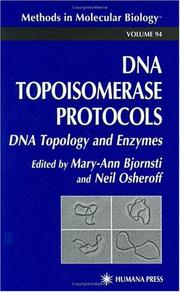
ISBN: 0585243999 0896034445 9786610830503 1280830506 1592592597 1617370398 Year: 1999 Publisher: Totowa, NJ : Humana Press : Imprint: Humana,
Abstract | Keywords | Export | Availability | Bookmark
 Loading...
Loading...Choose an application
- Reference Manager
- EndNote
- RefWorks (Direct export to RefWorks)
DNA Topoisomerase Protocols, I: DNA Topology and Enzymes brings together an unprecedented collection of cutting-edge experimental protocols for investigating DNA structure, topology, and DNA topoisomerase function. Described by expert experimentalists who have perfected the techniques, these unfailingly reproducible methods utilize new approaches to study changes in DNA topology (linking number, knotting, catenation, and relaxation) and DNA structure (bending), as well as to assess chromosome structure through FLP-mediated recombination and to analyze bacterial nucleoid structure. State-of-the-art protocols also detail the expression and purification of bacterial, viral, and eukaryotic DNA topoisomerases from a variety of sources, including baculovirus, and bacterial, yeast and mammalian expression systems. A companion volume, DNA Topoisomerase Protocols, v. 2: Enzymology and Drugs, provides detailed protocols to study the catalytic activities of DNA topoisomerases, as well as their specific interactions with topoisomerase-targeted antitumor and antibacterial drugs. DNA Topoisomerase Protocols, I: DNA Topology and Enzymes will be of immense value to the many basic scientists and clinicians who want better to understand and to exploit proficiently the wealth of recent discoveries about chromatin structure and its relation to gene expression, about DNA topoisomerases as the targets of antitumor and antibacterial agents, and about DNA repair.
DNA -- Conformation -- Laboratory manuals. --- DNA -- Structure -- Laboratory manuals. --- DNA topoisomerases. --- Electronic books. -- local. --- Human Anatomy & Physiology --- Health & Biological Sciences --- Animal Biochemistry --- DNA --- Structure --- Conformation --- Topoisomerases, DNA --- Isomerases --- Deoxyribonucleic acid --- Desoxyribonucleic acid --- Thymonucleic acid --- TNA (Nucleic acid) --- Deoxyribose --- Nucleic acids --- Genes --- Cytology. --- Cell Biology. --- Cell biology --- Cellular biology --- Biology --- Cells --- Cytologists
Periodical
Abstract | Keywords | Export | Availability | Bookmark
 Loading...
Loading...Choose an application
- Reference Manager
- EndNote
- RefWorks (Direct export to RefWorks)
Supramolecular chemistry --- Chimie supramoléculaire --- Supramolecular chemistry. --- Chemistry, Physical and theoretical --- Macromolecules --- Macromolecular Systems --- Chemistry --- Molecular Conformation --- Molecular Structure --- Structure, Molecular --- Molecular Structures --- Structures, Molecular --- Models, Molecular --- 3D Molecular Structure --- Configuration, Molecular --- Molecular Structure, Three Dimensional --- Three Dimensional Molecular Structure --- Molecular Configuration --- 3D Molecular Structures --- Configurations, Molecular --- Conformation, Molecular --- Conformations, Molecular --- Molecular Configurations --- Molecular Conformations --- Molecular Structure, 3D --- Molecular Structures, 3D --- Structure, 3D Molecular --- Structures, 3D Molecular --- Macromolecular Substances. --- Chemistry. --- Molecular Conformation. --- Molecular Structure. --- Macromolecular Complexes --- Macromolecular Compounds --- Macromolecular Compounds and Complexes --- Complexes, Macromolecular --- Compounds, Macromolecular --- Substances, Macromolecular --- Nanostructures --- Molecular structure. --- Chimie. --- Structure moléculaire. --- chemistry. --- molecular structure. --- Chemical structure --- Structural bioinformatics --- Physical sciences
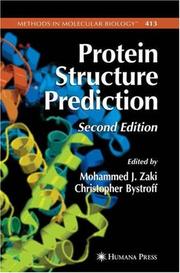
ISBN: 1597455741 1588297527 9781588297525 Year: 2008 Publisher: Totowa, NJ : Humana Press : Imprint: Humana,
Abstract | Keywords | Export | Availability | Bookmark
 Loading...
Loading...Choose an application
- Reference Manager
- EndNote
- RefWorks (Direct export to RefWorks)
For forty years we have known the essential ingredients for protein folding – an amino acid sequence, and water. But the problem of predicting the three-dimensional structure from its sequence has eluded computational biologists even in the age of supercomputers and high throughput structural genomics. Despite the unsolved mystery of how a protein folds, advances are being made in predicting the interactions of proteins with other molecules, such as small ligands, nucleic acids or other proteins. Protein Structure Prediction focuses on the various computational methods for prediction, their successes and their limitations, from the perspective of their most well-known practitioners. Leaders in the field provide insights into template-based methods of prediction, structure alignment and indexing, protein features prediction, and methods for de novo structure prediction. Protein Structure Prediction is a cutting-edge text that all researchers in the field should have in their libraries.
Biochemistry. --- Proteomics. --- Protein Science. --- Biochemistry, general. --- Molecular biology --- Proteins --- Biological chemistry --- Chemical composition of organisms --- Organisms --- Physiological chemistry --- Biology --- Chemistry --- Medical sciences --- Composition --- Amino acid sequence --- Protein Conformation --- Models, Molecular --- Probability --- 577.122 --- 577.122 Protein metabolism --- Protein metabolism --- Probabilities --- Molecular Models --- Model, Molecular --- Molecular Model --- Molecular Conformation --- Molecular Structure --- Conformation, Protein --- Conformations, Protein --- Protein Conformations --- Protein Folding --- Amino acid sequence analysis --- Analysis, Amino acid sequence --- Peptide sequence --- Peptide sequencing --- Protein sequence --- Protein sequencing --- Sequence, Amino acid --- Amino acids --- Sequence alignment (Bioinformatics) --- Structure&delete& --- Mathematical models --- Analysis --- Proteids --- Biomolecules --- Polypeptides --- Proteomics --- Structure
Periodical
ISSN: 23297778 Year: 2014 Publisher: Place of publication unknown AIP
Abstract | Keywords | Export | Availability | Bookmark
 Loading...
Loading...Choose an application
- Reference Manager
- EndNote
- RefWorks (Direct export to RefWorks)
Structural dynamics --- Models, Molecular. --- Structural dynamics. --- Building dynamics --- Dynamics, Structural --- Structural vibration --- Strains and stresses --- Structural analysis (Engineering) --- Molecular Models --- Model, Molecular --- Molecular Model --- Molecular Conformation --- Molecular Structure --- x-ray fel --- synchrotrons --- pulsed electrons sources --- nuclear dynamics --- diffraction --- Crystal chemistry
| Listing 1 - 10 of 31 | << page >> |
Sort by
|

 Search
Search Feedback
Feedback About UniCat
About UniCat  Help
Help News
News